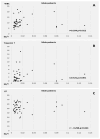Sex-Specific Impact of 17β-Estradiol and Testosterone Levels on Inflammation and Injury in Acute Myocardial Infarction-Preliminary Results
- PMID: 40564184
- PMCID: PMC12190329
- DOI: 10.3390/biomedicines13061466
Sex-Specific Impact of 17β-Estradiol and Testosterone Levels on Inflammation and Injury in Acute Myocardial Infarction-Preliminary Results
Abstract
Background: Estrogens play a protective role during the early stages of life. However, endogenous 17β-estradiol (E2) can accelerate atherosclerosis progression. Aim: The purpose of this study was to test for the significance of the sex-specific associations of gonadal hormones with the extent of the inflammatory response, myocardial damage, and ventricular arrhythmia risk in acute myocardial infarction (MI). Materials and Methods: Study design: single-center cohort study. Blood samples for the assessment of sex steroids (E2, total testosterone [T]), oxidized low-density lipoproteins, high-sensitivity C-reactive protein (CRP), white blood cell (WBC) counts, and cardiac enzymes were collected 48 h after the onset of symptoms (and within 6 h after PCI) from 111 patients (37% women) with acute MI. Coronary disease severity, left ventricular systolic function (LV), and indices of ventricular repolarization were assessed using coronary angiography, echocardiography, and a conventional electrocardiogram, respectively. Results: In men with acute MI, peak cardiac enzyme levels were predicted by post-percutaneous coronary intervention (PCI) E2 plasma levels, peak WBC count, and peak CRP plasma levels. T levels and the E2/T ratio were associated with post-PCI CRP in these men. For women, peak WBC count was a marker of highest testosterone, and only WBC count was a significant indicator of myocardial injury extent. The incidence of acute ventricular tachycardia detected in AMI was significantly associated with left ventricular ejection fraction and with peak WBC count (as a tendency) regardless of sex. A longer duration of cardiac repolarization prior to PCI was predicted by lower ejection fractions in men and by age, CRP, and testosterone levels in female patients. Conclusions: During acute MI, elevated endogenous estradiol levels in men and increased leukocytes in women indicate acute myocardial damage. Post-PCI plasma inflammatory markers are sex-specific confounding factors for acute endogenous E2 levels, T levels, and the E2/T ratio. LV systolic function in men and, characteristically, the acute inflammatory response and testosterone levels in women are predictors of longer ventricular repolarization and arrhythmia risk.
Keywords: 17β-estradiol; C-reactive protein; acute myocardial infarction; oxidized low-density lipoproteins; total testosterone; ventricular tachycardia.
Conflict of interest statement
The authors declare no conflicts of interest.
Figures




Similar articles
-
Sex-based differences in inflammatory predictors of outcomes in patients undergoing mechanical thrombectomy: an inverse probability weighting analysis.Ther Adv Neurol Disord. 2025 Jun 21;18:17562864251345719. doi: 10.1177/17562864251345719. eCollection 2025. Ther Adv Neurol Disord. 2025. PMID: 40547862 Free PMC article.
-
Testosterone to Oestradiol Ratio: A Significant Indicator for Prediction of Coronary Artery Disease in Males.J Coll Physicians Surg Pak. 2025 Jul;35(7):814-818. doi: 10.29271/jcpsp.2025.07.814. J Coll Physicians Surg Pak. 2025. PMID: 40605201
-
Exercise-based cardiac rehabilitation for coronary heart disease.Cochrane Database Syst Rev. 2016 Jan 5;2016(1):CD001800. doi: 10.1002/14651858.CD001800.pub3. Cochrane Database Syst Rev. 2016. Update in: Cochrane Database Syst Rev. 2021 Nov 6;11:CD001800. doi: 10.1002/14651858.CD001800.pub4. PMID: 26730878 Free PMC article. Updated.
-
Development of a multidimensional prediction model for long-term prognostic risk in patients with acute coronary syndromes after percutaneous coronary intervention: A retrospective observational cohort study.PLoS One. 2025 May 7;20(5):e0318445. doi: 10.1371/journal.pone.0318445. eCollection 2025. PLoS One. 2025. PMID: 40333795 Free PMC article.
-
Exercise-based cardiac rehabilitation for coronary heart disease.Cochrane Database Syst Rev. 2021 Nov 6;11(11):CD001800. doi: 10.1002/14651858.CD001800.pub4. Cochrane Database Syst Rev. 2021. PMID: 34741536 Free PMC article.
Cited by
-
Markers in Acute Coronary Syndrome: Distal Coronary Embolism at Percutaneous Coronary Intervention.J Cardiovasc Dev Dis. 2025 Aug 19;12(8):315. doi: 10.3390/jcdd12080315. J Cardiovasc Dev Dis. 2025. PMID: 40863381 Free PMC article.
References
-
- Chen I.J., Shoupe D., Karim R., Stanczyk F.Z., Kono N., Sriprasert I., Hodis H.N., Mack W.J. The association of hysterectomy with or without ovarian conservation with subclinical atherosclerosis progression in healthy postmenopausal women. Menopause. 2023;30:692–702. doi: 10.1097/GME.0000000000002192. - DOI - PMC - PubMed
-
- Lo A.C.Q., Lo C.C.W., Oliver-Williams C. Cardiovascular disease risk in women with hyperandrogenism, oligomenorrhea/menstrual irregularity or polycystic ovaries (components of polycystic ovary syndrome): A systematic review and meta-analysis. Eur. Heart J. Open. 2023;3:oead06. doi: 10.1093/ehjopen/oead061. - DOI - PMC - PubMed
Grants and funding
LinkOut - more resources
Full Text Sources
Research Materials
Miscellaneous

